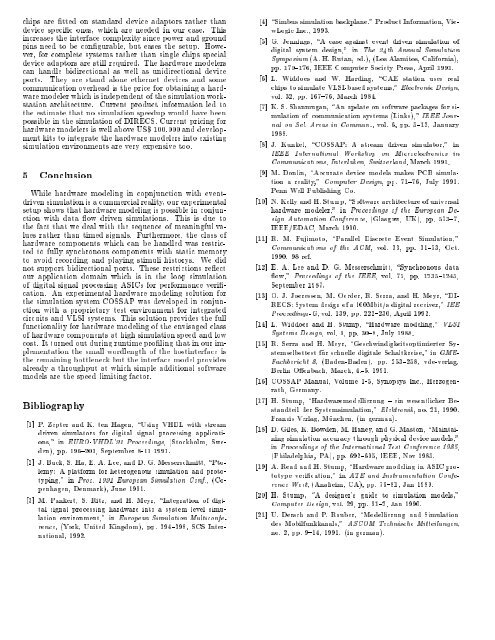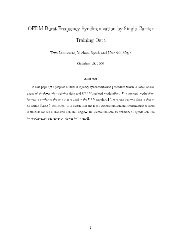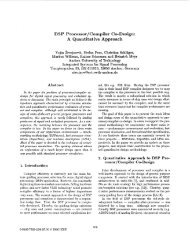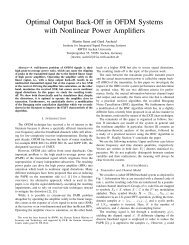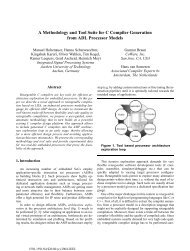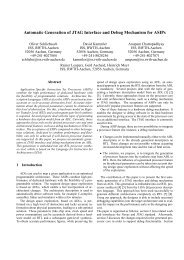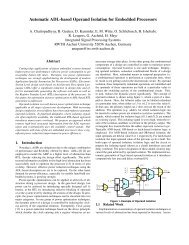Hardware \in the Loop" Simulation with COSSAP: Closing the ... - ICE
Hardware \in the Loop" Simulation with COSSAP: Closing the ... - ICE
Hardware \in the Loop" Simulation with COSSAP: Closing the ... - ICE
You also want an ePaper? Increase the reach of your titles
YUMPU automatically turns print PDFs into web optimized ePapers that Google loves.
chips are tted on standard device adaptors ra<strong>the</strong>r than<br />
device specic ones, which are needed in our case. This<br />
increases <strong>the</strong> interface complexity sincepower and ground<br />
pins need to be congurable, but eases <strong>the</strong> setup. However,<br />
for complete systems ra<strong>the</strong>r than single chips special<br />
device adaptors are still required. The hardware modelers<br />
can handle bidirectional as well as unidirectional device<br />
ports. They are stand alone e<strong>the</strong>rnet devices and some<br />
communication overhead is <strong>the</strong> price for obtaining a hardware<br />
modeler which is independent of <strong>the</strong> simulation workstation<br />
architecture. Current product information led to<br />
<strong>the</strong> estimate that no simulation speedup would have been<br />
possible in <strong>the</strong> simulation of DIRECS. Current pricing for<br />
hardware modelers is well above US$ 100.000 and development<br />
kits to integrate <strong>the</strong> hardware modelers into existing<br />
simulation environments are very expensive too.<br />
5 Conclusion<br />
While hardware modeling in copnjunction <strong>with</strong> eventdriven<br />
simulation is a commercial reality, our experimental<br />
setup shows that hardware modeling is possible in conjunction<br />
<strong>with</strong> data ow driven simulations. This is due to<br />
<strong>the</strong> fact that we deal <strong>with</strong> <strong>the</strong> sequence of meaningful values<br />
ra<strong>the</strong>r than timed signals. Fur<strong>the</strong>rmore, <strong>the</strong> class of<br />
hardware components which can be handled was restricted<br />
to fully synchronous components <strong>with</strong> static memory<br />
to avoid recording and playing stimuli historys. We did<br />
not support bidirectional ports. These restrictions reect<br />
our application domain which is in <strong>the</strong> loop simulation<br />
of digital signal processing ASICs for performance verication.<br />
An experimental hardware modeling solution for<br />
<strong>the</strong> simulation system <strong>COSSAP</strong> was developed in conjunction<br />
<strong>with</strong> a proprietary test environment forintegrated<br />
circuits and VLSI systems. This solution provides <strong>the</strong> full<br />
functionality for hardware modeling of <strong>the</strong> envisaged class<br />
of hardware components at high simulation speed and low<br />
cost. It turned out during runtime proling that in our implementation<br />
<strong>the</strong> small wordlength of <strong>the</strong> hostinterface is<br />
<strong>the</strong> remaining bottleneck but <strong>the</strong> interface model provides<br />
already a throughput at which simple additional software<br />
models are <strong>the</strong> speed limiting factor.<br />
Bibliography<br />
[1] P. Zepter and K. ten Hagen, \Using VHDL <strong>with</strong> stream<br />
driven simulators for digital signal processing applications,"<br />
in EURO-VHDL'91 Proceedings, (Stockholm, Sweden),<br />
pp. 196{203, September 8-11 1991.<br />
[2] J. Buck, S. Ha, E. A. Lee, and D. G. Messerschmitt, \Ptolemy:<br />
A platform for heterogenous simulation and prototyping,"<br />
in Proc. 1991 European <strong>Simulation</strong> Conf., (Copenhagen,<br />
Denmark), June 1991.<br />
[3] M. Pankert, S. Ritz, and H. Meyr, \Integration of digital<br />
signal processing hardware into a system level simulation<br />
environment," in European <strong>Simulation</strong> Multiconference,<br />
(York, United Kingdom), pp. 394{398, SCS International,<br />
1992.<br />
[4] \Simbus simulation backplane." Product Information, ViewLogic<br />
Inc., 1993.<br />
[5] G. Jennings, \A case against event driven simulation of<br />
digital system design," in The 24th Annual <strong>Simulation</strong><br />
Symposium (A. H. Rutan, ed.), (Los Alamitos, California),<br />
pp. 170{176, IEEE Computer Society Press, April 1991.<br />
[6] L. Widdoes and W. Harding, \CAE station uses real<br />
chips to simulate VLSI-based systems," Electronic Design,<br />
vol. 32, pp. 167{76, March 1984.<br />
[7] K. S. Shanmugan, \An update on software packages for simulation<br />
of communication systems (Links)," IEEE JournalonSel.Areas<br />
in Commun., vol. 6, pp. 5{12, January<br />
1988.<br />
[8] J. Kunkel, \<strong>COSSAP</strong>: A stream driven simulator," in<br />
IEEE International Workshop on Microelectronics in<br />
Communications, Interlaken, Switzerland, March 1991.<br />
[9] M. Donlin, \Accurate device models makes PCB simulation<br />
a reality," Computer Design, pp. 71{76, July 1991.<br />
Penn Well Publishing Co.<br />
[10] N. Kelly and H. Stump, \Software architecture of universal<br />
hardware modeler," in Proceedings of <strong>the</strong> European Design<br />
Automation Conference, (Glasgow, UK), pp. 573{7,<br />
IEEE/EDAC, March 1990.<br />
[11] R. M. Fujimoto, \Parallel Discrete Event <strong>Simulation</strong>,"<br />
Communications of <strong>the</strong> ACM, vol. 33, pp. 31{53, Oct.<br />
1990. 98 ref.<br />
[12] E. A. Lee and D. G. Messerschmitt, \Synchronous data<br />
ow," Proceedings of <strong>the</strong> IEEE, vol. 75, pp. 1235{1245,<br />
September 1987.<br />
[13] O. J. Joeressen, M. Oerder, R. Serra, and H. Meyr, \DI-<br />
RECS: System design of a 100Mbit/s digital receiver," IEE<br />
Proceedings-G,vol. 139, pp. 222{230, April 1992.<br />
[14] L. Widdoes and H. Stump, \<strong>Hardware</strong> modeling," VLSI<br />
Systems Design, vol. 9, pp. 30{8, July 1988.<br />
[15] R. Serra and H. Meyr, \Geschwindigkeitsoptimierter Systemselbsttest<br />
fur schnelle digitale Schaltkreise," in GME-<br />
Fachbericht 8, (Baden-Baden), pp. 253{258, vde-verlag,<br />
Berlin Oenbach, March, 4.-6. 1991.<br />
[16] <strong>COSSAP</strong> Manual, Volume 1-5, Synopsys Inc., Herzogenrath,<br />
Germany.<br />
[17] H. Stump, \<strong>Hardware</strong>modellierung { ein wesentlicher Bestandteil<br />
der Systemsimulation," Elektronik, no. 21, 1990.<br />
Franzis Verlag, Munchen, (in german).<br />
[18] D. Giles, K. Bowden, M. Haney, and G. Maston, \Maintaining<br />
simulation accuracy through physical device models,"<br />
in Proceedings of <strong>the</strong> International Test Conference 1985,<br />
(Philadelphia, PA), pp. 692{695, IEEE, Nov 1985.<br />
[19] A. Read and H. Stump, \<strong>Hardware</strong> modeling in ASIC prototype<br />
verication," in ATE and Instrumentation Conference<br />
West, (Anaheim, CA), pp. 76{81, Jan 1989.<br />
[20] H. Stump, \A designer's guide to simulation models,"<br />
Computer Design, vol. 29, pp. 91{2, Jan 1990.<br />
[21] U. Dersch and P. Rauber, \Modellierung und <strong>Simulation</strong><br />
des Mobilfunkkanals," ASCOM Technische Mitteilungen,<br />
no. 2, pp. 9{14, 1991. (in german).


